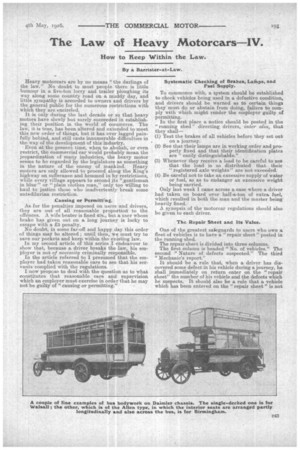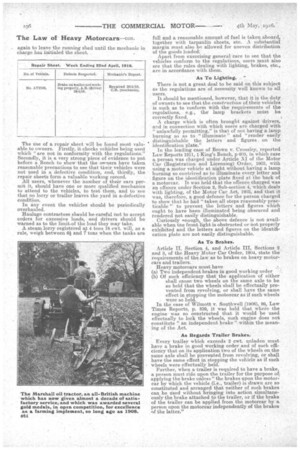The Law of Heavy Motorcars—IV.
Page 13

Page 14

If you've noticed an error in this article please click here to report it so we can fix it.
How to Keep Within the Law.
By a Barrister-at-Law.
Heavy motorcars are by no means "the darlings of the law." No doubt to most people there is little humour in a five-ton lorry and trailer ploughing its way along some country road on a muddy day, and little sympathy is accorded to owners and drivers by the general public for the numerous restrictions with which they' are encircled.
It is only during the last decade or so that heavy motors have slowly but surely succeeded in establishing their position in the world of commerce. The law, it is true, has been altered and extended to meet this new order of things, but it has ever lagged painfully behind, and still casts innumerable difficulties in the way of the development of this' industry.
Even at the present time, when to abolish, or even restrict, the commercial ear would probably mean the jeopardization of many industries, the heavy motor seems to be regarded by the legislature as something in the nature of the enemy of mankind. Heavy motors are only allowed to proceed along the King's highway on sufferance and hemmed in by restrictions, while every village appears to second its "gentleman in blue" or "plain clothes man," only too willing to haul to justice those who inadvertently break some antediluvian restriction.
Causing or Permitting.
As for the penalties imposed on users and drivers, they are out of all reasonable proportioft to the offences. A wife beater is fined 40s., but a user whose brake has given out on a long journey is lucky to escape with a 25 penalty.
No doubt, in some far-off and happy, day this order of things ma Y be altered ; until then, we must try to save our pockets and keep within the existing law. In my second article of this series I endeavour to show that, because a driver breaks the law, his employer is not of necessity criminally responsible.
In the article referred to I presumed that the employer had taken reasonable care to see that his servants complied with the regulations.
I now propose to deal with the question as to what constitutes that reasonable care and supervision which an employer must exercise in order that he may not be guilty of "causing or permitting."
Systematic Checking of Brakes, Lafiaps, and Fuel Supply.
To commence with; a system should be established to check vehicles being used ia a defective condition, and drivers should be warned as to certain things they must do or abstain from doing, failure to comply with which might render the employer guilty of permitting.
In the first place a notice should be. posted in the "running shed" directing drivers, inter alma, that they shall—
(1) Test the brakes of all vehicles before they set out on a journey.
(2) See that their lamps are in working order and properly fixed and that their identification plates are easily distinguishable.".
(3) Whenever they receive a load to be careful to see that the load is so distributed that their "registered axle weights" are not exceeded: (4) Be careful not to take an excessive supply of water or fuel, so as to endanger an excessive weight being earned.
Only last week I came across a case where a driver had taken on board over half-a-ton of extra fuel, which resulted in both the man and the master being heavily fined.
A synopsis of the motorcar regulations should also be given to each driver.
The Repair Sheet and Its Value.
One of the greatest safeguards to users who own a fleet of vehicles is to have a 'repair sheet" posted in the running shed.
The repair sheet is divided into three columns.
The first column is headed "No. of vehicles." The second "Nature of defects suspected." The third "Mechanic's report."
It should be a rule that, when a driver has discovered some defect in his vehicle during a journey, he shall immediately on return enter on the "repair sheet" the number of his vehicle and the defects which he suspects. It should also be a rule that a vehicle which has been entered on the "repair sheet" is not
The use of a repair sheet will be found most valuable to owners. Firstly, it checks vehicles being used which "are not in conformity with the regulations." Secondly, it is a very strong piece of evidence to put before a Bench to show that the owners have taken reasonable precautions to see that their vehicles were not used in a defective condition, arid, thirdly, the repair sheets form a valuable working record. All users, whenever the number of their cars permit it, should have one or more qualified mechanics to attend to the vehicles, to test them, and to see that no lorry or trailer leaves the yard in a,clefective condition.
In any event the vehicles should be periodically overhauled.
Haulage contractoos sheuld be-careful not to accept orders for excessive loads, and drivers should be warned as to the limitof the load they may take.
A ,steam lorry-registered at 4 tons 18 cwt. will, as a rule, weigh between 64 and 7 tons when the tanks are
full and a reasonable amount of fuel is taken aboard, together with tarpaulin sheets, etc. A substantial margin must also be allowed for uneven distribution of the goods loaded. Apart from exercising general 'care to see that the vehicles conform to the regulations, users must also see that the rules dealing with lighting, brakes, etc., are in accordance with them.
As To Lighting.
There is not a great deal to be said on this subject as the regulations are of necessity well known to all users.
It should be mentioned, however, that it is the duty of owners to see that the construction of their vehicles is such as to conform with the requirements of the regulations,. e.g., the lamp brackets must be correctly fixed.
A charge which is often brought against drivers, and in. connection with which users are charged with " unlawfully permitting," is that of not having a lamp burning so as to " illuminate " and "render easily , distinguishable the letters and figures on the idemtification plate."
In the leading case of Brown y. Crossley, reported Law Reports 1911, 1 King's Bench, p 603, in which case a person was charged under Article XI of the Motor Car (Registration and Licensing) Order, 1903, with using a motor vehicle at night without having a lamp burning so contrived as to illuminate every letter and figure on the identification plate fixed at. the back of a motorcar. It was held that the offence charged was an offence under Section 2, Sub-section 4, which deals with lighting, of the Motor Car Act, 1903, and that it was, therefore, a good defence for the person charged to show that he had "taken all steps reasonably. practicable "to prevent the letters and figures which ought to have been illuminated being obscured and tendered not easily distinguishable.
. Curiously enough, the above defence is not available when the front light is obstructed or not properly exhibited and the letters and figures on the •identification plate are not easily distinguishable.
As To Brakes.
Article II, Section 4, and Article III, Sections 2 and 3, of the Heavy Motor Car Order, 1904, state the requirements of the law as to brakes on heavy motorcars and trailers.
Heavy motorcars must have (a) Two independent brakes in good working order . (b) Of such efficiency that the application of either shall cause two wheels on the same axle to be so held that the wheels shall be effectually prevented from revolving, or shall have the same effect in stopping the motorcar as if such wheels were so held.
In the case of Wilmott v. Southwell (1908), 99, Law Times Reports, p. 839, it was held that where the engine was so constructed that it would be used effectually to lock the wheels, such engine does not constitute "an independent brake" within the meading of the Act.
As Regards Trailer Brakes.
Every trailer which exceeds 2 cwt. unladen must have a brake in good working order and of such efficiency that on it application two of the wheels on the same axle shall be prevented from revolving, or shall have the same effect in stopping the vehicle as if such wheels were effectually held.
Further, when a trailer is required to have a brake, a person must ride upon the trailer for the purpose of, applying the brake unless " the brakes upon the motorcar by which the vehicle (i.e. trailer) is drawn are so ccrnstituted and arranged that neither of such brakes• can be used without bringing into action simultaneously the brake attached to the trailer, or if the brake of the trailer can be applied from the motorcar by a person upon the motorcar independently crf the brakes of the tatter."




















